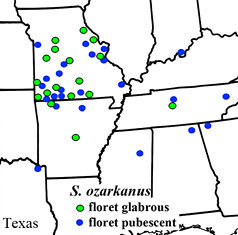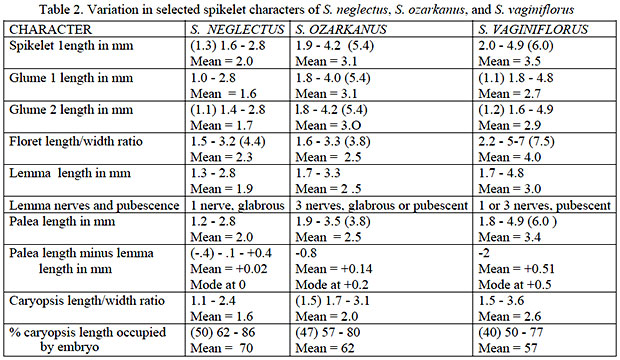

Two recent keys that deal with the Sporobolus complexes of interest — i.e., The Flora of North America (FNA) and The Flora of Missouri (FM) — both make valuable contributions, but differ in their interpretation at the species level; i.e., FM recognizes Sporobolus ozarkanus Fernald as a distinct species whereas FNA considers it a variety, Sporobolus vaginiflorus var. ozarkanus (Fernald) Shinners.
Sporobolus ozarkanus Fernald was published (Rhodora 35:109) in part on the basis of “its quite glabrous lemmas and strongly pubescent leaves,” the type specimen, with glabrous florets, being E. J. Palmer 3133 (GH). The FNA key (and description) exclude the possibility of recognizing the type specimen: the path to the var. ozarkanus must satisfy the condition “lemmas strigose.” In contrast, the FM key has two branches to deal with glabrous lemmas; i.e., #7 for S. compositus & #9 for S. ozarkanus. Note that this duplication does not reflect the decision to treat it as distinct species, since if the FNA were to recognize the glabrous lemmas of the var. ozarkanus, it would require similar duplication to distinguish that form from S. neglectus.

With regard to the S. compositus complex one significant contribution of the FNA treatment is the recognition that the lemma surface of S. clandestinus may be either pubescent or scabridulous. [See vestiture page.]
Recognition of the rhizomatous forms of both S. clandestinus and S. compositus in the FNA key (#6 ⇒ #10, #34) requires a similar duplication. This is not a problem with the FM key, since rhizome presence is not a distinctive character in that key, S. clandestinus and S. compositus being paired only by relative glume length.
Unique in the FM key is relative glume length (#5) as a primary character distinguishing the S. compositus complex from the S. vaginiflorus complex. This reduces some of the difficulty of identification using the annual/perennial distinction I have observed with young plant determinations; e.g., S. clandestinus, A.L. Ripple 51-1058. But the annual/perennial distinction has not been entirely eliminated, since glume length apparently doesn't always suffice to distinguish S. clandestinus from pubescent forms of the S. vaginiflorus complex. [The annual/perennial differentia has persisted since A. S. Hitchcock’s key for Sporobolus (Manual of the grasses of the United States 1935, p. 392).]
In my opinion the FM treatment is superior in its treatment of the S. vaginiflorus complex. The descriptions show that the excellent M.S. theis of R. L. Riggins (1969) has been consulted (unlike the FNA, which references only her later treatment of the S. compositus complex). Riggins makes a compelling case for the status of S. ozarkanus as a distinct species. In 1969 Riggins examined Texas collections at TEX/LL, SMU and TAES and found no S. ozarkanus in the state; and at all herbaria visited found only 1 Texas S. ozarkanus collection from the NE corner of the state (Bowie Co.; G.W. Letterman 27 [MO]). (Riggins did, however, determine several non-Texas collections at TEX as S. ozarkanus.)
C.G. Reeder’s treatment in F.W. Gould 1975 (The Grasses of Texas) closely follows Riggins, recognizing both glabrous and pubescent forms of S. ozarkanus Fernald; and at times using detailed measurements provided in Riggins 1969 key without attribution or inclusion in the references:
Reeder:
floret length/width ratio 1.6-3.3 (-3.8) … floret length/width ratio 2.2-5.7 (-7.5)
Riggins:
floret length/width ratio 1.6 - 3.3 (3.8) … floret length/width ratio 2.2 - 5.7 (7.5)
Of the 32 collections at TEX/LL that Riggins determined to be S. vaginiflorus, 17 were determined to be S. ozarkanus or S. vaginiflorus var. ozarkanus in later visits by R.L. McGregor (1988) or S.L. Hatch (1995). In McGregor et al. 1986 (Flora of the Great Plains) David Sutherland’s Sporobolus article does not include S. ozarkanus although he notes (p. 1229):
This species appears to be somewhat intermediate between S. vaginiflorus and S. neglectus but has some distinctive features of its own, for example, 3-nerved lemmas and pilose lower sheaths. Cytological and field study of this complex is needed.Sutherland’s article lists Reeder as reference, but shows that he is unaware of Riggin’s thesis, which is an excellent field study of taxa of this complex. I am led to wonder whether McGregor in examining TEX Sporobolus holdings already seen by Riggins was aware of her detailed field study; e.g., the table of spikelet characters below (click to enlarge).
